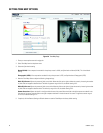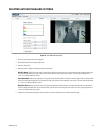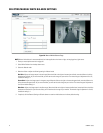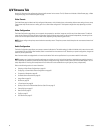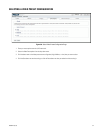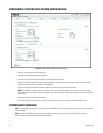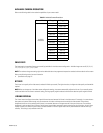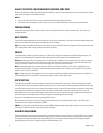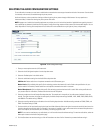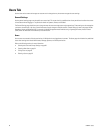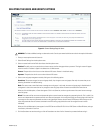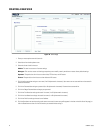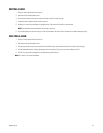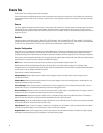57 C2963M-C (8/10)
QUALITY OF SERVICE FOR DIFFERENTIATED SERVICES CODE POINT
Quality of Service (QoS) for Differentiated Services Code Point (DSCP) is a code that allows the network to prioritize the transmission of different
types of data. This setting is only available with H.264.
NOTES:
• If you are not familiar with DSCP, contact your network administrator before changing this setting.
• Your network must be configured to use QoS. If you are unsure if your network is QoS-aware, contact your network administrator.
ENDURA SIGNING
Enabling the Endura Signing feature allows an Endura
®
system to authenticate video from an Endura recorded stream. This setting is only
available with H.264.
RATE CONTROL
The rate control setting determines the bit rate and quality of each frame in the video stream. There might be a trade-off between image quality
and the resources required for video storage when selecting a rate control setting.
CBR: The constant bit rate (CBR) streams video at a fixed number of bits per second. CBR uses the full capacity of the bit rate setting for scenes
with or without motion. Video is always streamed at the user bit rate setting.
PROFILE
The profile defines the subset of bit stream features in an H.264 stream, including color reproduction and additional video compression. It is
important that the selected profile is compatible with the recording device so that a stream can be decoded and viewed.
Baseline: A simple profile with a low compression ratio. A baseline profile is compatible with more recorders but uses more bits to compress
quality video than the other profiles. This profile supports I-frames and P-frames. Use the baseline profile in applications with limited scene
changes; for example, an indoor scene with a single, unchanging primary light source and minimal motion.
Main: An intermediate profile with a medium compression ratio. Main is the default profile setting. This profile is compatible with most
recorders and uses fewer bits to compress video than the baseline profile; however, it uses more bits than the high profile. The main profile
supports I-frames, P-frames, and B-frames.
High: A complex profile with a high compression ratio. This is the primary profile for high-definition television applications; for example this is
the profile adopted for Blu-ray and HD-DVD. The high profile supports I-frames, P-frames, and B-frames.
GOP STRUCTURE
The group of pictures (GOP) structure is the sequence in which frames are placed within a video stream. The GOP structure always includes
intra-coded frames (I-frames) and predictive coded frames (P-frames), but it can also include bi-directionally predictive coded frames (B-frames).
Each GOP structure starts with an I-frame: an image of the complete scene that is used as the reference frame in the structure. P-frames record
data changes that are different than the previous frame. This allows the video encoder to save space since the data of the I-frame is not
duplicated. B-frames not only capture data changes from the previous frame, but they also capture the data changes from the frame after the
B-frame. B-frames are more compressed than P-frames and require more processing power to be decoded.
The camera can be configured to use one of the following GOP structures:
IP: A compression that uses only I-frames and P-frames to provide low latency and a high level of decoder support. This GOP structure is
compatible with more recorders and decoders than IBBrBP.
IBBrBP: The most sophisticated H.264 compression available. IBBrBP provides the highest quality image at a given bit rate, but it also increases
the latency of the video and requires more processing power for decoders.
ADVANCED SHARPENING
The Advanced Sharpening setting enhances picture detail by sharpening the edges in the picture. When this mode is enabled, there is a trade-off
between image quality and the resources required for processing power. The maximum camera resolution and image rate will not be available,
but the edges of the image seem sharper. Only use this setting if you cannot achieve the sharpness level you want by adjusting the digital
processing settings of the camera. The default setting for Advanced Sharpening is Off.



